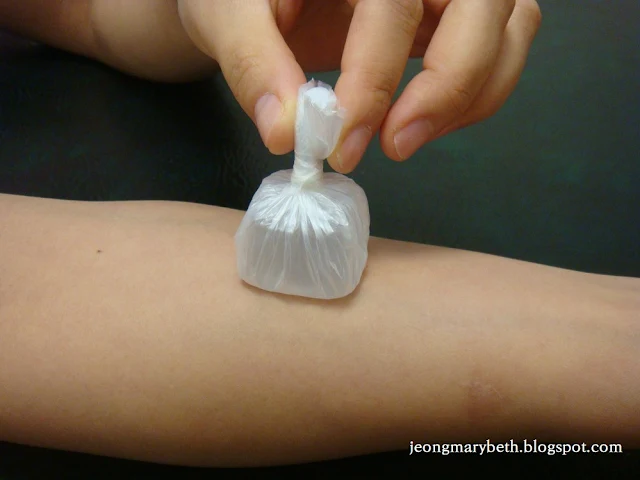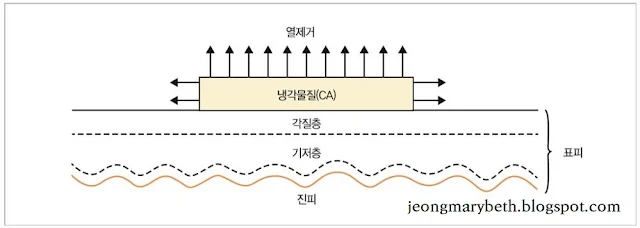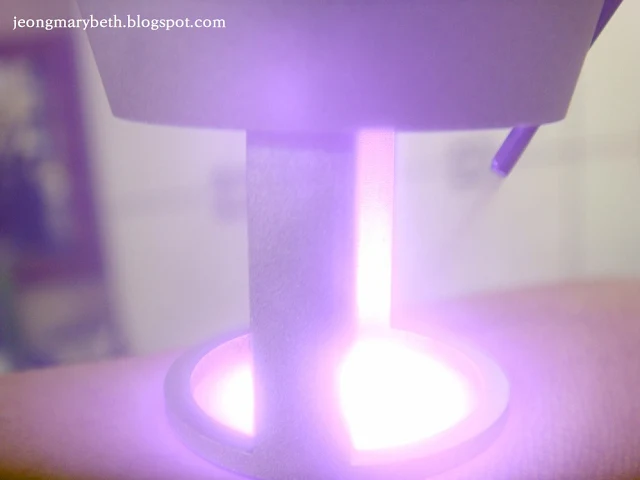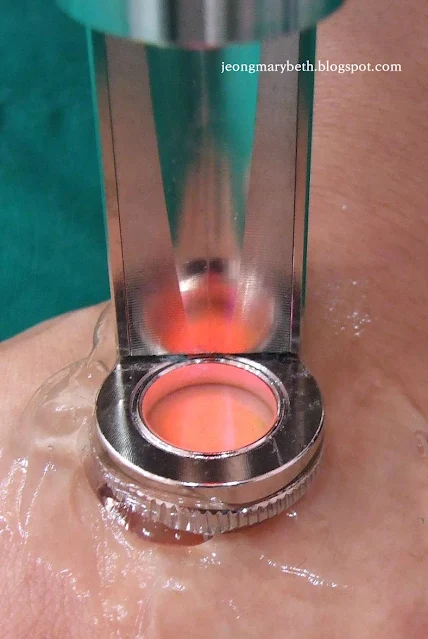I. 피부 냉각장치
 |
| 사진 3-6-I-1. 얼음 조각을 이용한 피부의 냉각 |
레이저 시술로 인한 열 손상으로 흉터와 색소침착이 발생하는 것을 줄이기 위한 노력의 하나로, 1982년 Gilchrest 등은 아르곤레이저로 포도주색모반을 치료하기 전 2~3분간 얼음 조각을 이용해 피부를 냉각시키는 방법을 보고하였다. 레이저에 의한 비특이적인 열 효과로부터 각질형성세포와 섬유모세포가 보호받을 수 있어서 더 나은 결과를 보인다는 것이다. 레이저 시술 전 조직을 냉각시키는 이와 같은 기초적인 노력은 이후 레이저 핸드피스 팁에 접촉 냉각장치를 부착하거나, 냉각 스프레이를 이용한 동적 냉각(dynamic cooling) 방식으로 이어지는 계기가 되었다.
모든 피부냉각 방법들은 열을 피부로부터 기체, 액체 또는 저온의 고체와 같은 어떤 접촉 냉각물질까지 제거하는 기전을 가진다. 특히 높은 출력과 긴 조사시간이 요구되는 제모용 레이저나 혈관 병변 치료용 레이저는 치료 효과를 높이고 부작용을 피하기 위해 반드시 표피를 냉각시켜 보존할 필요가 있다. 그러므로 이러한 레이저들은 표피 손상을 감소시키기 위하여 여러 가지 냉각장치를 사용하고 있는데, 현재 두 가지의 냉각방식이 주로 이용되고 있다.
 |
| 그림 3-6-I-2. 피부냉각의 개요 |
(1) 분사방식
 |
| 사진 3-6-I-3. 분사방식 |
테트라플루오로에탄(tetrafluoroethane)과 같은 냉매를 분사하여 냉각 효과를 나타내는 냉매분사방식을 말한다. 이러한 냉각방식은 냉각속도가 빠르고 선택적인 냉각이 가능한 장점이 있지만, 피부의 결빙을 초래할 수 있고 경우에 따라 피부에 비가역적인 변화를 초래할 수도 있다는 단점을 가지고 있다.
(2) 접촉방식
 |
| 사진 3-6-I-4. 접촉방식 |
냉각수가 순환되고 있는 사파이어판을 피부에 직접 접촉하여 피부 온도를 떨어뜨리는 접촉냉각방식을 말한다. 피부의 결빙이 발생하지 않아 시술이 안전하다는 장점이 있지만, 시술 중 지속적으로 피부를 냉각시키므로 사용 시간만큼 진피까지 온도가 낮아져, 에너지 효율이 떨어진다는 단점이 있다.
하지만 두 방식 모두 표피 기저부의 온도가 -5°C ~ 5°C 사이로 냉각 효과의 차이는 없는 것으로 알려진다. 10msec 이상의 조사시간을 가지는 롱펄스 레이저에 있어서는 접촉냉각방식이 유리하고, 10msec 이하의 조사시간을 가지는 레이저에서는 냉매분사방식이 유리하다는 견해가 있다. 모발과 같이 열이완시간이 긴 경우는 접촉냉각방식이 좋고, 산화헤모글로빈이나 멜라닌세포처럼 열이완시간이 짧은 경우에는 냉매분사방식이 효과적이라는 것이다. 또한, 냉각된 공기를 이용하는 경우도 있는데, 이는 조사시간이 짧은 펄스형 레이저 사용 시에 효과적인 것으로 알려지고 있다.
참고문헌
2. 박영립, 홍창권, 김문범 등. 피부질환의 치료. In: 대한피부과학회 교과서편찬위원회. 피부과학. 제6판. 도서출판 대한의학 2014: 914.
3. 박승하. 레이저성형. 군자출판사 2008: 36-7.
*1. Altshuler GB, Zenzie HH, Erofeev AV, Smirnov MZ, Anderson RR, Dierickx C. Contact cooling of the skin. Phys Med Biol 1999; 44 (4): 1003-23.
*2. Anderson RR, Parrish JA. Selective photothermolysis: precise microsurgery by selective absorption of pulsed radiation. Science 1983; 220: 524–7.
*3. Anvari B, Milner TE, Tanenbaum BS, Kimel S, Svaasand LO, Nelson JS. A theoretical study of the thermal response of skin to cryogen cooling and pulsed laser irradiation: implications for the treatment of port wine stain. Phys Med Biol 1995; 40: 1451–65.
*4. Anvari B, Milner TE, Tanenbaum BS, Kimel S, Svaasand LO, Nelson JS. Selective cooling of biological tissues: application for thermally mediated therapeutic procedures. Phys Med Biol 1995; 40: 241–52.
*5. Anvari B, Ver Steeg BJ, Milner TE, Tanenbaum BS, Klein TJ, Gerstner E, Kimel S, Nelson JS. Cryogen spray cooling of human skin: effects of humidity level, spraying distance, and cryogen boiling point. Proc SPIE 1997; 3192: 106–10.
*6. Buscher BA, McMeekin TO, Goodwin D. Treatment of leg telangiectasia by using a long-pulse dye laser at 595 nm with and without dynamic cooling device. Lasers Surg Med 2000; 27 (2): 171-5.
*7. Chess C. Does simultaneous contact cooling reduce intravascular temperature during laser irradiation and impinge on selective vascular destruction? Dermatol Surg 1998; 24 (3): 404-5.
*8. Chess C. Regarding the use of contact cooling devices during laser treatment of spider leg veins. Dermatol Surg 2000; 26 (1): 92-3.
*9. Fiskerstran EJ, Ryggen K, Norvang LT, Svaasand LO. Clinical effects of dynamic cooling during pulsed laser treatment of port-wine stains. Lasers Med Sci 1997; 12 (4): 320-7.
*10. Gilchrest BA, Rosen S, Noe JM. Chilling port wine stains improves the response to argon laser therapy. Plast Reconstr Surg 1982; 69 (2): 278-83.
*11. Klavuhn KG, Green D. Importance of cutaneous cooling during photothermal epilation: theoretical and practical considerations. Lasers Surg Med 2002; 31 (2): 97-105.
*12. Nahm WK, Tsoukas MM, Falanga V, Carson PA, Sami N, Touma DJ. Preliminary study of fine changes in the duration of dynamic cooling during 755-nm laser hair removal on pain and epidermal damage in patients with skin types III-V. Lasers Surg Med 2002; 31 (4): 247-51.
*13. Nelson JS, Majaron B, Kelly KM. Active skin cooling in conjunction with laser dermatologic surgery. Semin Cutan Med Surg 2000; 19 (4): 253-66.
*14. Nelson JS, Milner TE, Anvari B, Tanenbaum BS, Kimel S, Svaasand LO, Jacques SL. Dynamic epidermal cooling during pulsed laser treatment of port wine stain: a new methodology with preliminary clinical evaluation. Arch Dermatol 1995; 131: 695–700.
*15. Torres JH, Anvari B, Milner TE, Tanenbaum BS, Milner TE, Yu JC, Nelson JS. Internal temperature measurements in response to cryogen spray cooling of a skin phantom. Proc SPIE 1999; 3590: 11–9.
*16. Waldorf HA, Alster TS, McMillan K, Kauvar AN, Geronemus RG, Nelson JS. Effect of dynamic cooling on 585-nm pulsed dye laser treatment of port-wine stain birthmarks. Dermatol Surg 1997; 23 (8): 657-62.
*17. White JM, Siegfried E, Boulden M, Padda G. Possible hazards of cryogen use with pulsed dye laser. A case report and summary. Dermatol Surg 1999; 25 (3): 250-2.
*18. Zenzie HH, Altshuler GB, Smirnov MZ, Anderson RR. Evaluation of cooling methods for laser dermatology. Lasers Surg Med 2000; 26 (2): 130-44.

댓글 없음:
댓글 쓰기